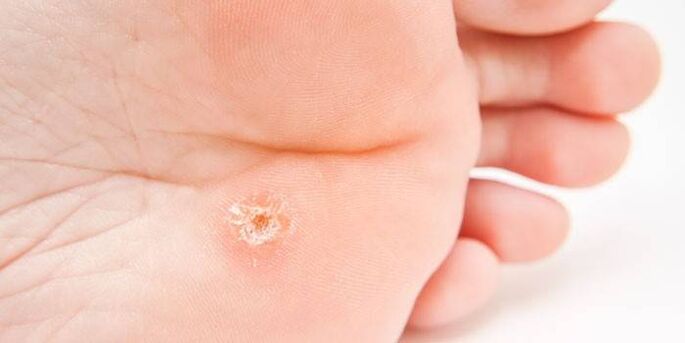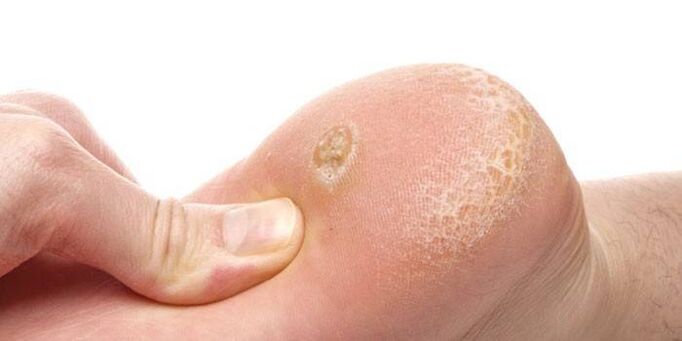Since ancient times, ugly body formations trouble humanity. A wart on the foot is a skin disease caused by a virus. People with skin defects were avoided, fearing infection, and when they noticed a neoplasm in the sole of the foot or in another part of the body, they tried to remove it as quickly as possible. What people don't apply to their plantar warts, since they disappear forever. Until now, dermatologists have been looking for the most effective and painless method of dealing with the condition.
what is a wart
The human papillomavirus causes a benign or cancerous DNA mutation in skin cells. The body is covered with papillomas, warts, papules. More than one hundred types of HPV have been studied. A wart is a tumor on the skin that signals the presence of the first or third type of papilloma virus in the body. Neoplasms are potentially non-cancerous, but extremely infectious due to the pathogen's viability in the external environment.
What does a leg wart look like?
A plantar neoplasm is round in shape with clear edges a few millimeters or centimeters in size. In the center, black dots of clogged capillaries are visible. On the leg, they look like old dry calluses that have grown on the skin. The pain of plantar growth does not manifest itself under direct pressure, but under compression. The absence of papillary lines on the foot is characteristic.

Causes of plantar warts
HPV infections are more frequent with unprotected sex. The virus penetrates through microcracks in the mucous membranes of Organs genitals. Someone's HPV is "in transit", while others are less fortunate - the virus remains in the body, unnotified for a long time. Dermatologists do not rule out that the appearance of papillomas on the surface of the feet is caused by immunological disorders and infectious diseases.
Walking barefoot in public places: baths, swimming pools, beauty salons, shared bathrooms, on the beach, trying on bare shoes are the most common causes of plantar warts. The virus is viable outside its host and "looks around waiting for the victim" on towels, tiles, facecloths, furniture, guest slippers, etc. The infection is attracted to dense, tense areas of skin on the plantar surfaces and palms of the hands, where the papilloma virus enters through small lesions.
Warts on children's legs
Children are restless, often hurt. Parents may not be aware of the presence of HPV in the child's body, obtained through cuts and abrasions. With the weakening of immunity, the virus becomes active, the papilloma appears in the leg. Painful methods of dealing with leg warts in children are often contraindicated and poorly tolerated. Often the child's body faces this skin condition on the feet alone.
Types of Warts on Legs
Warts are a set of skin lesions caused by papilloma. Depending on the external manifestation, the impact on human health, the following types of warts are classified:
- vulgar (common) - keratinized round blisters;
- flat - a blemish-like rash rising above the skin;
- filiform (acrocords) - elongated with "torn" edges, formed in the folds of the body;
- genital warts - reminiscent of a rooster's comb;
- senile (keratomas) - occur in the elderly, are not associated with HPV.
Wart formations are located throughout the body, in internal organs, in the oral cavity. Warts on the feet, called plantar warts, are a common type. One type includes well-formed ones, which are a pressed depression in the skin characterized by rapid growth. The appearance of subungual growths slightly elevates the nail plate.

Treatment of plantar warts
It is dangerous to neglect the treatment of plantar warts. Foot neoplasms are constantly injured. They are removed to stop new growths and infections from entering. There is no complete cure for HPV. Treatment is reduced to turning the disease into a "sleep mode". Available medication, surgical, immunomodulatory removal of plantar warts, using alternative medicine.
The disadvantage of treating plantar growths lies in their location: the large stratum corneum of the epidermis makes it difficult to apply active substances in the depth of the formation in the foot. In preparation for therapy, the top layer of buildup is soaked and exfoliated. Traditionally, the treatment of warts on the feet starts with the use of salicylic acid. The wart on the foot is sprayed daily for three months in a bath, disinfected, then the softened top layer is cleaned with a pumice stone, salicylic acid is applied and a patch is applied.
Pharmacy chains advise how to get rid of a wart on your leg with the help of medications that contain celandin, phenol and trichloroacetic acid. The drugs cause tissue necrosis, relieving the patient of the deficiency, but leave a trail of healing from a deep wart wound. Each disease is individual to varying degrees, so before choosing a method to remove a wart on the sole of your foot, you should ask your doctor for advice.
Ointment
According to the method of action, there are antiviral, necrotizing herbal ointments. In the first case, the acid or alkali in the base of the ointment cauterize the painful growth and leave a scar. At home, for foot treatment, you can use liquid solutions: with acetic, nitric, oxalic, lactic acid in the composition. To avoid burns, the surface of the neoplasm is rigorously processed.
Antiviral foot wart ointment is applied to the tumor itself and the surrounding area to reduce the growth of the infection. They are used with special ointments. Herbal ingredients only affect skin formation. Known for its effectiveness in treating foot balm with an applicator, Colhamin ointment.
Modern removal methods
The advent of modern wart removal methods has replaced the traumatic scalpel. Similar to a surgeon's scalpel, the electrocoagulator burns the neoplasm in the foot with current. After the removal procedure with laser or radio waves, a depression remains in the foot. Healing takes several weeks. Exposure to liquid nitrogen is considered a very painful treatment and requires multiple treatments. In 2014, British dermatologists published material on the latest antigen injection therapy. This will help patients who are resistant to existing treatments.

folk remedies
The procedures with folk remedies for warts on the legs are performed before bedtime, with the feet pre-vaporized and for a long time. During handling, protect your hands with latex gloves against the spread of infection, disinfect all used devices and things to prevent infection of loved ones. List of Popular Effective Ways to Get Rid of a Wart:
- Garlic is known for its antibiotic properties. In a neoplasm on the sole of the foot, the hard top layer is cut away, a thin clove of garlic is applied.
- You can make "anti-shave putty". It is crushed with finely grated garlic, vinegar, wheat flour, spread on the surface of the neoplasm and sealed with plaster. After a few days, the mass is removed along with the buildup.
- Apply a vinegar-infused onion to the foot or you can rub the plant with vinegar and then add a new onion.
- You can fill the formation with the juice of medicinal plants: celandine, Kalanchoe, marigold, milkweed, dandelion, golden mustache, or attach a slice of apple, ash, figs, potatoes, horseradish, cabbage. The procedure is performed daily, lasting from several weeks to months, until the build-up disappears.
- You can apply water-diluted wood ash to a creamy state.
- The growth is sprinkled with powdered ground chalk and wrapped with a bandage. The compress cannot be wet.
- Birch and willow barks containing salicyl are proven to be effective in the treatment. The peel is applied to the foot, previously softening it with boiling water.
- Hot footbaths with sea salt, soda, washing powder, tea tree oil, or fir broth help treat foot ailments. Treatments can be mixed or alternated.
- Absinthe broth applications are used. 3 tablespoons of dried wormwood herb are prepared in a cup of boiling water, insisting for at least 2 hours.














































































